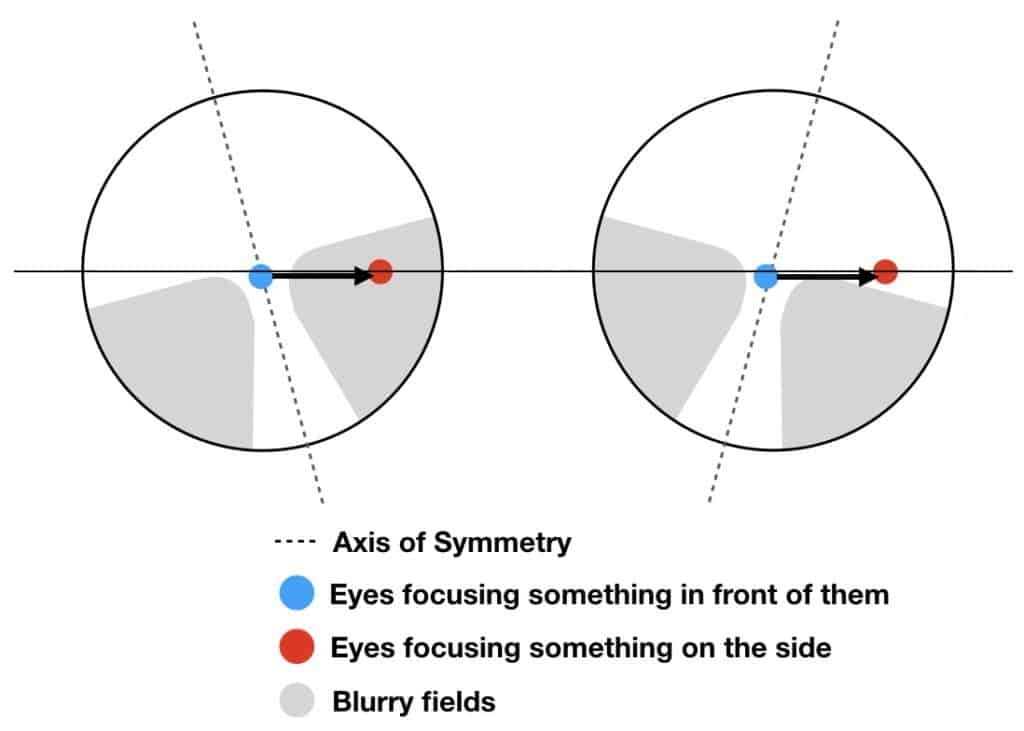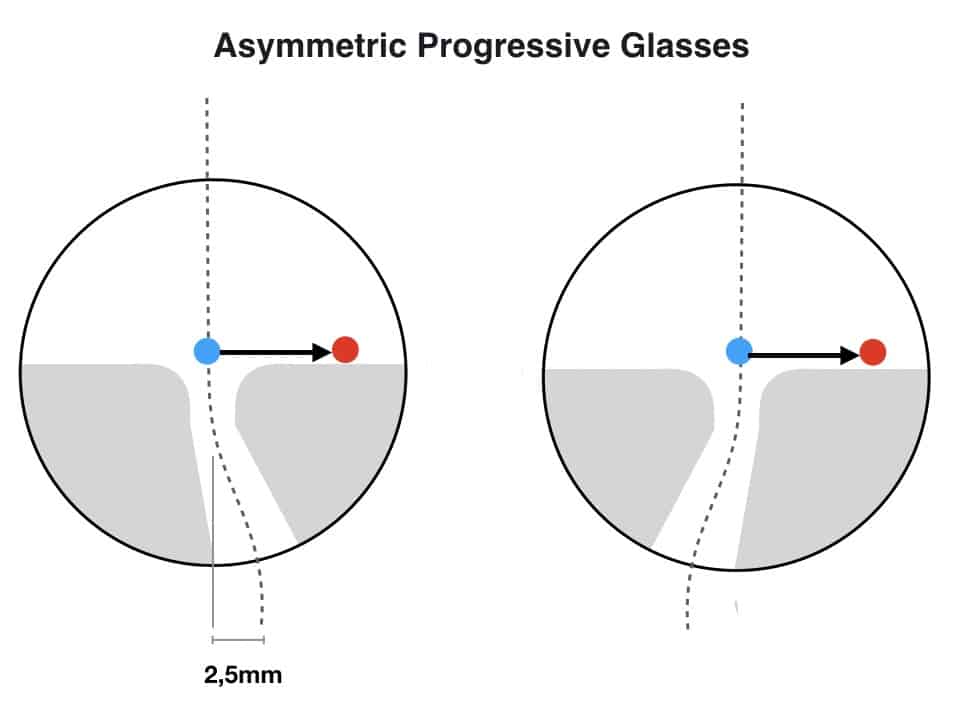There are different types of progressive glasses you can buy. In this article, I will explain the differences to you to guide your next choice when buying your new progressives.
- symmetric progressive glasses
- asymmetric progressive glasses
- freeform progressive glasses
- individual progressive glasses
- standard progressive glasses
- comfort progressive glasses
- premium progressive glasses
- high-end progressive glasses
- digital progressives
- HD progressive lenses
Here in this listing above you find some terms that actually make a difference in which lens you get in your glasses. A lot of terms are just advertising language without any background. Hence there is no definition for some terms it can vastly vary what they actually mean from optician to optician.
Symmetric vs Asymmetric Progressive Glasses
When the first progressives came out in 1959 the lens was built in a symmetrical design. Such a design has an axis of symmetry. You have a point for distance vision and as you follow the axis straight down the reading power increases until you reach the full support for reading. But you do not perform eye movements that go straight down while read. Your eyes converge and those lenses were not made for the right or left eye. Before they were built into your frame they had to be rotated a bit to take your eyes convergence into account.

That lead to fields of view that were different in the distance in your right and left eye. Because you always have distortions in progressive lenses. If they are rotated into your field of view you will recognize them more. In comparison, asymmetric progressive lenses do not have to be rotated in to take your eye’s convergence into account. They provide reading zones that are a little bit more narrow (2.5mm (this distance is called Inset)) compared to the point of distance vision and are asymmetrically produced for the left and right eye.
With this change in production, the distortions of the lenses are better distributed to provide the wearer with the same vision in his right and the left eye as he performs eye movements in the distance. Today this is common practice in the lower-priced progressive lenses as in the higher-end models. In seldom cases, if people just using one eye it can be required to abstain from inset and go back to a more symmetrical progressive design. But that case is rare.
For a long time, the Inset of 2,5mm was just a standard parameter. But if you compare a really tall guy with a big pupilar distance and a smaller woman with a smaller face and therefore a smaller pupilar distance. You will find out pretty fast that both of them have different angles and distances in which they read. But the Inset was set and did not fit most people. So the manufacturers had to come up with a more individual approach to target the visual needs of wearers of progressives. And so they did.

Individual Progressive Lenses Explained
During the year 2000 Rodenstock and Zeiss took the first approach in actually taking into account how the frame sits in the face of the wearer and how the lenses fit the frame. Before the manufactures were not able to consider if a progressive lens sits 16mm or 9mm in front of a face. But if you think about it nose of an Asian or European can vastly change the way in which the progressives fit. Those parameters are:
- Vertex Distance
- Pantoscopic Tilt
- Wrap Angle
- Reading Distance
- Pupilar Distance
- The Form of the Frame
With those parameters customized for the wearer, there are still pretty much the same distortions in the lenses as before but they are much better distributed on the lens surface. So the wearer can experience a wider field of view and more often faster adaptation to the progressive glasses.
If needed individual progressive lenses can change the experience of progressives a lot. Oftentimes those lenses are marketed as premium lenses.
What Is the Difference Between Premium, Comfort and Standard Lenses?
First of all those terms are just made up. It is marketing jargon. Each of them does not actually tell you a thing about the lenses. So it could be a difference. Oftentimes Highend or premium progressives provide individual parameters but it is nothing that says it has to be that way. And you also can not figure things out by yourself just by comparing prices. Because you can get individualized lenses from lower-priced manufacturers and well-established brands.
The names are just there to name different categories of progressive lenses but what is in the category is decided by the optician. Speaking of confusing terms… let us talk about freeform progressive lenses.
What Are Freeform Progressive Lenses?
Freeform technology-enabled manufacturers to produce an individualized lens design. Nearly every manufacturer today produces freeform progressive glasses. However, that does not mean it is a particular sign of quality. Because you can get freeform manufactured lenses from the cheapest up to the very high end.
And on the lower end, the progressive lens designs can not be customized to your needs as in really good lenses. The term came up in the 80s but when Zeiss Vision launched the Gradal Individual in the 2000s which was a milestone in the world of progressives freeform already was there for nearly 20 years. And now manufacturers are using it as something which stands out.
What Are Digital Progressive Lenses?
In some cases, “digital” is being used as a synonym for individual progressives. In other sources, people are telling that digital lenses provide a specific accuracy which is not true. Sure digital sounds good but that does not mean immediately you will get the lens that has no distortions. As you will see in the video you will recognize, nearly all terms are describing individual progressive lenses. The same is true for HD lenses.
Although measuring the parameters digitally can have a lot of advantages still a lot of mistakes can be made. The process here described in the video is the centration part. In this part, the points in which your progressive lens is the sharpest for the distance is directly placed in front of the eye. This ensures the clearest and most relaxed vision. If you leave your natural posture during this part is likely that the points for the best vision are out of place.
Side note
One thing that is really good in the video above is the shown blurred fields. Usually when you buy new progressives the “digital lens designs” are shown in the marketing brochures to hardly have any of those blurs in the sides which is just not true. The lenses get optimized but the way they work is still the same as these parameters were measured with a ruler.
With this article, I wanted to get a more in-depth understanding of the different terms. If you are already wearing highly customized progressive glasses with individual parameters correctly you can not expect a totally new experience of vision in new premium, digital, HD, or high-end lenses. Assuming the lens power is still the same in the old and new glasses.
